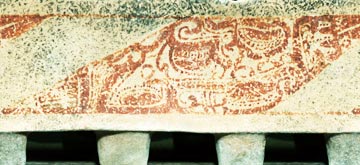Here are two examples of pottery. If you can figure out the date of the pottery, the iconography, and the importance of these specific two pots for aspects of the evolutionary transition within the ceramic sequence, you have achieved more than most people with 20 years of field experience.
If you cannot figure these out (they are at Ph.D. level of complexity), then you know what an iconographer goes through to try to understand these two paintings. These two paintings are actually the missing links between two major periods of Maya art. These paintings, and the dozen others painted in the same pre-Columbian ateliers, will necessitate rewriting one chapter of the history of Maya ceramics and ceramic sequence of form and design.

Hint, nothing like these vessels has ever been published in any archaeological report on the ceramic sequence of any Maya site.
Hint, but that does not make these non-Maya, or non-entities either. In actuality, these two pots are representatives of one of the largest class of painted pots of their time and place.
Yet one Ph.D. dissertation on Maya ceramics effectively indicated that no pot such as this existed in the ceramic sequence. In actuality, these two pots might very well have come from within 100 miles of the area the Ph.D. dissertation was supposed to cover.
Where can you find additional hints? There may be a photo of a related vessel (different color scheme but same general concept) in "Tikal Copan," Nicholas Hellmuth, 1978.
Other clues are buried within another one of Hellmuth's monograph on Maya ceramics.
The answer is buried within another one of Hellmuth's monographs, on Maya ceramics. This book describes several pots painted by the same or related atelier.
How do we figure out this mass of scrolls and scribbles? First we dedicated 30 years to find and photograph as many previously unknown Maya vases, plates, and bowls as we could find throughout the world. Then we began to catalog all of these, and found about a dozen which are similar to the two pictured here. If all you have are two of them, it is hard to figure out what is going on. But if your university, museum, or nearby library happened to have the entire FLAAR Photo Archive, in digital format, then you could just type in a few search words and the computer would present you all the information, along with full-color pictures of all the pots that are pertinent to your inquiry.
If you think you have the answer, please e-mail us at ReaderService@FLAAR.org and we will find one of our symposium Workbooks to send you (pardon us if we are a bit slow, since we are preparing for an upcoming project with the rollout cameras).
We will also print your name and your solution, and then offer our solution (keeping in mind this is rather advanced iconography and several aspects have not yet been resolved, not even by the specialists).































